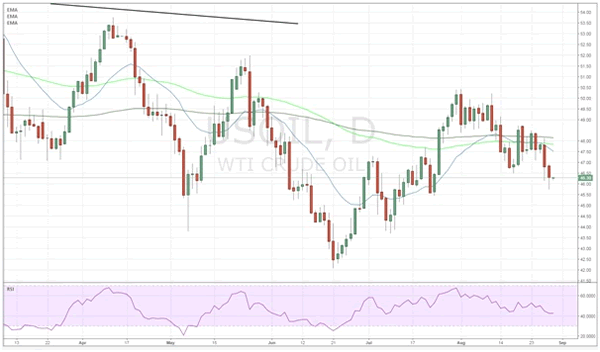Key Points:
- Crude oil supply glut worsens as tankers stuck offshore awaiting refinery openings.
- Meteorological data suggests storm could target Louisiana refinery area.
- Monitor the pending EIA Crude Oil Inventory figures which are due out shortly.
Crude oil prices have remained under pressure overnight as the ongoing damage from flooding in Texas, and the Gulf Coast, continues to wreak havoc amongst refineries. Subsequently, in what is being touted as potentially the most expensive of the decade, is severely impacting refinery operations throughout most of the U.S. In fact, if the rain and flooding continues to move as predicted, we could see further ramifications for gasoline production in the wider Southern regions. Subsequently, there could be further price declines for the black gold on the cards in the coming days.
Presently, WTI prices are trading around the $46.29 a barrel mark and are down around 1.17% for the prior day. However, what is potentially very interesting is the fact that oil and gasoline prices have diverged strongly as, due to the lack of refinery capacity, crude oil supplies continue to stack up. In fact, at last count there are currently 9 oil tankers offshore from Texas awaiting an opportunity to unload. Subsequently, the supply glut is likely to worsen as more tankers continue to arrive with little prospect of increased refinery operations in the near term.

In fact, prospective damage to the Gulf Coast refineries is yet to be assessed and it could be a significant period of time before they are again returned to full capacity. Additionally, many of the roads and infrastructure around these key supply points have been damaged and it remains uncertain as to what extent they will be able to be utilised to carry product. Subsequently, there still remains plenty of unknown factors and a rapid return to maximum production seems fairly unlikely.
Subsequently, the market could potentially be dealing with a significant crude oil supply glut for at least the next few weeks as both refinery and infrastructure damages are assessed and accounted for. Additionally, it would still take significant time to process the current crude oil stockpiles even if full capacity was returned rapidly. However, if the storm continues to move towards the Louisiana refineries, as met data seems to suggest, we could be in for a much deeper decline in crude oil prices.
Ultimately, WTI prices are likely to remain around the $46.00 handle in the coming days until further information is received on the status of the Texas based refineries and the surrounding infrastructure. However, monitor the EIA’s weekly oil inventory data because this could provide somewhat of a cushion to crudes bearishness if it shows a moderate draw.














